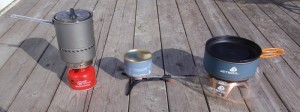
High-End Backpacking Canister Stoves: MSR Reactor vs Jetboil Helios
For years, I’ve used an original Jetboil for ultralight backpacking, as a backup, and for making French press coffee out in the woods. A great product, and a real game changer in the stove world, thanks to the Fluxring heat exchanger on the pot. A year or so ago, though, Tim got an MSR Reactor. It’s a different world…faster, bigger, better in every way, with a high-efficiency catalytic heating system and a heat exchanger of its own. He’s been drinking his tea and laughing at me while I’ve been waiting for my water to boil. But, mine’s a much older technology product…how does the Reactor compare to the new products from Jetboil?
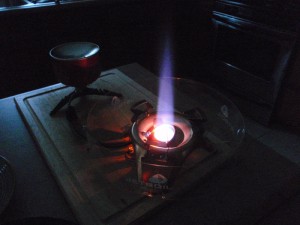
Well…turns out that there are a couple of different ways to look at this. The most similar product in Jetboil’s lineup in terms of pure function is the Flash…but that’s about half the price of the Reactor. On the other hand, the Jetboil Helios Cooking System is about the same price as the Reactor, and uses a new burner design. And, they’re rated to boil water at almost exactly the same rate, which is one of the standard measures of how good a stove is. So…let’s give them a test and see how they stack up!
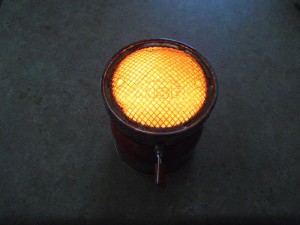
Out of the box, they’re both very unusual looking beasts. The Reactor hides its heat exchanger in its base, but the Helios hangs it out there for the world to see. That raises a slight question of durability…will the Fluxring, as the Jetboil heat exchanger is called, get damaged? Based on my years old original Jetboil, it’s relatively hard to do. Still, the Reactor wins a point on that one. And it wins on the windscreen, as well…the Jetboil comes with one that’s pretty functional, but the Reactor doesn’t need one. A third point in favor of the MSR is the cover design…very functional and easy to use. The Jetboil’s is, frankly, a total pain in the neck. It’s difficult to get on at the best of times, and when we tested it winter camping, it shrank and wouldn’t go back on. That’s unacceptable in a high quality stove. A Jetboil spokesman told me that the issue has been addressed, and that shortly a modified cover will be coming in the kits. [UPDATE, 1/16/2012: Jetboil sent a new version, and we took it out in temperatures as low as -8F; while the stove didn’t work at that temperature (canister stoves, even using the canister upside down, aren’t designed for extreme cold), the cover was flawless, going on and off easily. Nice work!]
One other caution: The windscreen can’t be used with any pot/pan that isn’t Jetboil Flux Ware designed for the Helios. That information IS printed on the windscreen itself, but in relatively small white letters; we missed it at first look. The only other place that it’s mentioned is deep in the virtually undecipherable owner’s manual. However, stick a frying pan on the Helios as I did, and within seconds you’ll learn that the heat that the flux ring would catch spills past the pan and melts the screen. I luckily was watching closely, and yanked the pan before I did any major damage; the windscreen still functions fine. Yes, there’s a warning, but we’d like to see it in bright orange lettering on the front of the owner’s manual or more obvious on the windscreen itself.
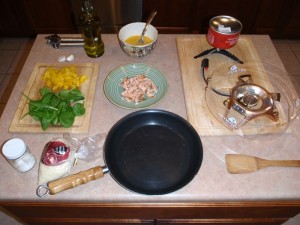
Finally, the Reactor weighs 18 ounces; the Helios, 29. A clear win for the MSR on that point, although the Jetboil does include two plates; the top and bottom covers for the Fluxring pot do double duty. Okay, so…there’s the advantages of the MSR over the Helios. What about the other way around? Well, the most obvious one is that you CAN use any pan you want on it. The Reactor only accepts its own kettle…which holds 1 liter of liquid, and that’s it. Just to see how it would do, I put my cheap 10″ backpacking frypan on the Helios and made an omelet. Susan gave it a definite thumbs up…the only weakness was a little browning in the middle. If I’d used my Calphalon, it would probably have done a better job than my home gas range! The flame pattern of the Helios resembles the output of a rocket engine…it throws a flame about 10 inches high…and when you put a pan on it, it spreads out and directly heats the entire bottom.
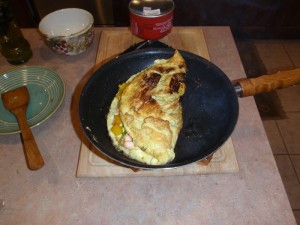
Another advantage of the Jetboil is that the pan that comes with it is a 2 liter. Sure, if you’re one person, the Reactor’s 1 liter is fine…but if there’s 2 or more, you may need a larger pot. And there are other pieces available with the Fluxring attached…there’s a frypan and a 3 liter. Very nice.
A third advantage is that the Helios is a 2-piece setup, with the stove itself separate from the canister (which mounts upside down, using the fuel as a liquid instead of a gas…more on that later). That means more stability, as the stove sits lower and wider. And, finally, my single favorite thing about the setup…a piezo ignitor. I absolutely hate struggling with matches when it’s windy, or when I’m waking up and turning on my stove without getting out of my sleeping bag for that first cup of coffee. Turn on the regulator, press the button, snap, it’s lit!
Overall, we gave the Helios the advantage on ergonomics. But, of course, easy to use is usLESS if the stove doesn’t perform. And both of these units are about performance, claiming superb boil times; Jetboil’s box says 3 minutes for 1L at 68 degrees F, MSR claims the same time for the Reactor(although they don’t give the starting temperature for the water). That’s great…if they really live up to their hype. We tested both stoves with MSR canister fuel, since it’s the most commonly available, then repeated the tests with the Jetboil using its own fuel, since they claim it works better with it. We didn’t try to get the water temperature to 68 degrees…but we DID make sure that the water was exactly the same for both stoves by putting it the pans the night before, and letting it sit overnight. The stoves and fuel were also left to sit where the testing were done, so were at the ambient temperature. Testing was done with full canisters, with the warm and cold tests using the same canister. When we used the Jetboil fuel, we put a fresh canister on the MSR to make sure the results weren’t skewed by changing performance as a canister emptied.
First test, cold, both with MSR fuel. Ambient temp 28 degrees, water temp 68 degrees. Reactor, 5:52; Helios, 6:43. Second test, warm/MSR, ambient temp 68, water temp 68. Reactor, 3:14; Helios, 3:19. For the third and 4th tests, we used the Jetboil fuel for the Helios. Third test, warm. Ambient temp 64, water temp 64. Reactor, 3:10; Helios w/Jetboil fuel, 2:39. Fourth test, cold. Ambient temp 26 degrees, water 67, Reactor, 6:38; Helios w/Jetboil fuel, 5:35.
Interesting. Clearly, the Jetboil fuel works better, at least with the Helios; additional testing with different stoves would be necessary to make that a blanket statement. However, one thing that was MORE than clear was that the Helios worked better at sub-freezing temperatures. The Reactor was cranky and difficult to start, taking two matches one time, three matches the other, and needing a couple of minutes to warm up before it would drop into its glowing catalytic mode. The Jetboil lit immediately every time, taking at most a couple of seconds to go to full blowtorch mode. So, even allowing for the longer boil time with the MSR fuel, if we’d actually started both stoves at the same time and put the water on immediately, the Jetboil would have come to a boil faster. In controlled conditions, we definitely can say that we’d rather use the Jetboil in the cold than the Reactor, hands down.
By the way, in a largely unscientific side test, I let the water sit in the two pots after the final test for about a half hour, and then measured the temperature in both; the water in the Jetboil pot was about 10 degrees warmer than in the Reactor. That would tend to indicate that the neoprene “cozy” around the Fluxring pot actually does do a relatively good job of insulating, and keeping your tea/coffee/soup/chicken cacciatore warm.
But, life isn’t always as neat as that…in the field, things can change, like the stupid cover shrinking. That said, the Helios worked like a charm in the field. It was stable, easy to start, and worked flawlessly at 20 degrees. I burned the bottom of our chicken cacciatore and learned that the pot is emphatically not nonstick…it was a pain to clean. But, when we rolled over at 5 a.m. and pressed the piezo ignitor and had instant flame, all was forgiven. And being able to use the Fluxring pot to get that first cup of coffee, and then switch over to Tim’s little GSI tea kettle while I organized breakfast made the morning much more efficient. Packing up…well, that’s when we found out about its shrinkage issue (with apologies to Jerry Seinfeld), so had to tuck it inside the trash bag on the way out to keep from making a mess of my pack. Definitely, the new cover will be a huge help!
Given all of the above…which is the better stove? And, as with so many things, the answer lies in your needs. The Reactor does one thing, and does it extremely well…it boils liquids. It’s fast, it’s compact, and it’s light. Given the design, it seems likely that it’ll be more fuel efficient than the Helios, although we didn’t specifically test for that. If you’re a hiker that lives on Ramen noodle stew, and doesn’t do any winter camping, it’s utterly ideal. If, on the other hand, you’re a backpacker who rarely goes out alone, and who believes that man does not live by Ramen alone…well, the Helios wins by virtue of its flexibility. A backpacking stove that can cook nearly as well as my home gas range is a rarity at any price or weight; the Jetboil does it at a competitive price and a moderate weight. It’s a bit like taking my old Peak 1 multi-fuel stove, then improving it in every way; it’s the Swiss Army knife of camp cooking. I don’t see Tim giving up his Reactor anytime soon, particularly when he’s going out alone…but if we had a choice, we’d take the Helios when we go backpacking together!


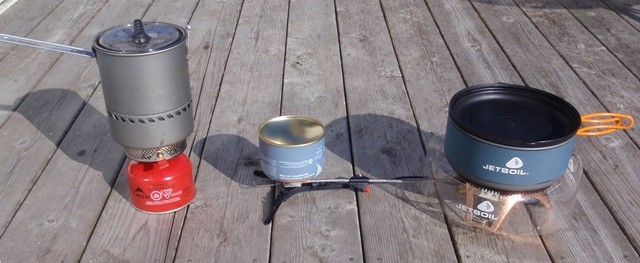
I am considering a helios and this article was very helpful. I wonder if the lid issue has been fixed yet.
thanks for passing on the info from your tests.
Burgess-
I contacted Jetboil, and found that the lid that’s currently coming with the Helios is the same as the one we tested. 2011 production will have the new lid. So, if you plan on using the stove in sub-freezing temperatures, you may want to wait until next spring to buy. I did ask Jetboil if they would replace the old lid with the new lid if someone buys now and requests it; I haven’t gotten a response to that yet. If I find out they will, I’ll let you know. Thanks for reading the article!
David,
I plan to purchase a Helios soon for backpacking this winter as an alternative to the always reliable (but involved to the point of ritual) liquid fuel stoves. Please add my mail address and inform me if Jetboil plans to replace the old lid. Thank-You for your consideration.